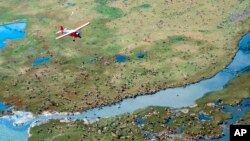The Trump administration said Thursday it would spend $4 million on construction projects in the Arctic National Wildlife Refuge in preparation for oil drilling in the nation’s biggest wildlife park.
In an announcement that touted planned improvements to U.S. Fish and Wildlife Service visitor facilities, the Department of the Interior said it has approved spending on projects for “Oil Exploration Readiness” in the coastal plain of the Arctic refuge.
The Trump administration is pushing for an oil lease sale in the refuge as early as next year. The tax-overhaul bill passed by the U.S. Congress last December includes a provision mandating two oil lease sales, each offering at least 400,000 acres (161,874.26 hectares), within seven years.
True wilderness refuge
The 19-million-acre (7.7 million-hectare) Arctic refuge, the largest in the U.S. national wildlife refuge system, contains some of the wildest territory in North America. There are no roads, established trails or buildings within the refuge border, and no cell phone service, according to the Fish and Wildlife Service.
“This is a true wilderness refuge,” the Arctic refuge website advises.
Political and business leaders in oil-dependent Alaska have tried for decades to pry open the refuge’s coastal plain, which is believed to hold potential for billions of barrels of oil.
But the plain, between the mountains of the Brooks Range and the Arctic Ocean, is prized for its importance to caribou, polar bears and other wildlife. Oil development there had been banned until Alaska Senator Lisa Murkowski led a move to insert a pro-drilling provision into the 2017 tax bill signed by President Donald Trump.
Some Alaskans opposed
In Alaska, the development plan is largely embraced, but not universally so. Drilling opponents gathered outside of last week’s Anchorage and Fairbanks hearings about the proposed lease sales to protest the plan.
Interior spokeswoman Heather Swift, in an email, said the $4 million “will be used to support six projects designed to improve and construct existing outbuildings, facilities and research operations.”
That work will include improvements to facilities outside the refuge, in the Inupiat village of Kaktovik and at Galbraith Lake along the Trans-Alaska Pipeline corridor, she said in the email.
Large appropriation
The $4 million appropriation for Arctic refuge projects is one of the largest single items in a total of $50 million in planned DOI construction spending.
“The president is a builder, he loves to build and he loves our public lands, so it is a natural fit that the Trump administration is dedicating so much attention to rebuilding our aging Fish and Wildlife Service infrastructure,” Secretary Ryan Zinke said in a statement Thursday.
A partnership of three companies is seeking to do seismic surveys in the refuge starting this winter. That plan, from SAExploration and two Alaska Native corporations, was panned by the U.S. Fish and Wildlife Service, the Washington Post reported last month.
There has been no decision on that application, Swift said Thursday. “It was a draft application. The department does not make decisions based upon early drafts,” she said by email.

